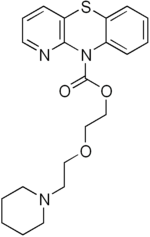Chemistry:Pipazetate
 | |
| Clinical data | |
|---|---|
| Trade names | Dipect, Lenopect, Selvignon, Selvigon, Theratuss, Toraxan |
| Other names | Pipazethate; D-254; LG-254; SKF-70230A; SQ-15874 |
| AHFS/Drugs.com | International Drug Names |
| Routes of administration | oral |
| ATC code | |
| Legal status | |
| Legal status |
|
| Identifiers | |
| |
| CAS Number |
|
| PubChem CID | |
| DrugBank | |
| ChemSpider | |
| UNII | |
| KEGG | |
| Chemical and physical data | |
| Formula | C21H25N3O3S |
| Molar mass | 399.51 g·mol−1 |
| 3D model (JSmol) | |
| |
| |
| (verify) | |
Pipazetate (Template:Abl) (brand names Dipect, Lenopect, Selvigon, Theratuss, Toraxan), or pipazethate (Template:Abl), is a 1-azaphenothiazine drug that was briefly marketed as a cough suppressant.[1][2] It binds to the sigma-1 receptor with an IC50 value of 190 nM.[3] It also has local anesthetic action, and in large doses can produce seizures.[4]
As the brand name Theratuss, it was approved by the FDA in 1962, on evidence of safety only. It was withdrawn from the US market in 1972 when the manufacturer, E.R. Squibb, and Sons, failed to produce evidence of efficacy.[5] Clinical studies showed that it did not decrease cough frequency at recommended dosages.[6]
Infrequent side effects include nausea, vomiting, drowsiness, fatigue, rash, and tachycardia.[6]
Synthesis
Note: 1-azaphenothiazine is also used for making Prothipendyl & Isothipendyl.
The reaction of 1-azaphenothiazine [261-96-1] (1) with phosgene gives 1-azaphenothiazine-10-carbonyl chloride [94231-78-4] (2). The reaction of this reactive intermediate with 2-[2-(piperidyl)ethoxy]ethanol [3603-43-8] (3) gives the ester, thus completing the synthesis of Pipazethate (4).
References
- ↑ The Dictionary of Drugs: Chemical Data: Chemical Data, Structures and Bibliographies. Springer. 14 November 2014. pp. 985–. ISBN 978-1-4757-2085-3. https://books.google.com/books?id=0vXTBwAAQBAJ&pg=PA985.
- ↑ Index Nominum 2000: International Drug Directory. Taylor & Francis. 2000. pp. 1418–. ISBN 978-3-88763-075-1. https://books.google.com/books?id=5GpcTQD_L2oC&pg=PA1419.
- ↑ "Dextromethorphan binding sites in the guinea pig brain.". Cellular and Molecular Neurobiology 8 (2): 149–156. October 10, 1988. doi:10.1007/BF00711241. PMID 3044591.
- ↑ Martín, Alfonso Velasco (2004). "Tratamiento sintomático de la tos y del resfriado común". Farmacología clínica y terapéutica médica. p. 259. ISBN 9788448604271.
- ↑ "Certain Preparations Containing Dihyprylone or Pipazethate Hydrochloride; Notice of Withdrawal of Approval of New-Drug Applications". Federal Register 37 (152): 15887. August 5, 1972. FDC–D–458. https://www.govinfo.gov/content/pkg/FR-1972-08-05/pdf/FR-1972-08-05.pdf.
- ↑ 6.0 6.1 Council on Drugs (1971). AMA Drug Evaluations (Report). Chicago: American Medical Association. p. 360–3. https://archive.org/details/amadrugevaluatio00coun. Retrieved April 5, 2021.
- ↑ Schuler, Wilhelm A.; Klebe, Hans; Schlichtegroll, Ansgar V. (1964). "Synthesen von 4-Aza-phenothiazinen, II. Derivate der 4-Aza-phenothiazin-10-carbonsäure". Justus Liebigs Annalen der Chemie. 673 (1): 102–112. doi:10.1002/jlac.19646730114.
- ↑ Schuler Wilhelm Alfons, U.S. Patent 2,989,529 (1961 to Degussa).
- ↑ Bernd Dr. Lehmann & Bernhard Petrat, EP patent 0527298 (1997 to Meda Pharma GmbH and Co KG).
 |


